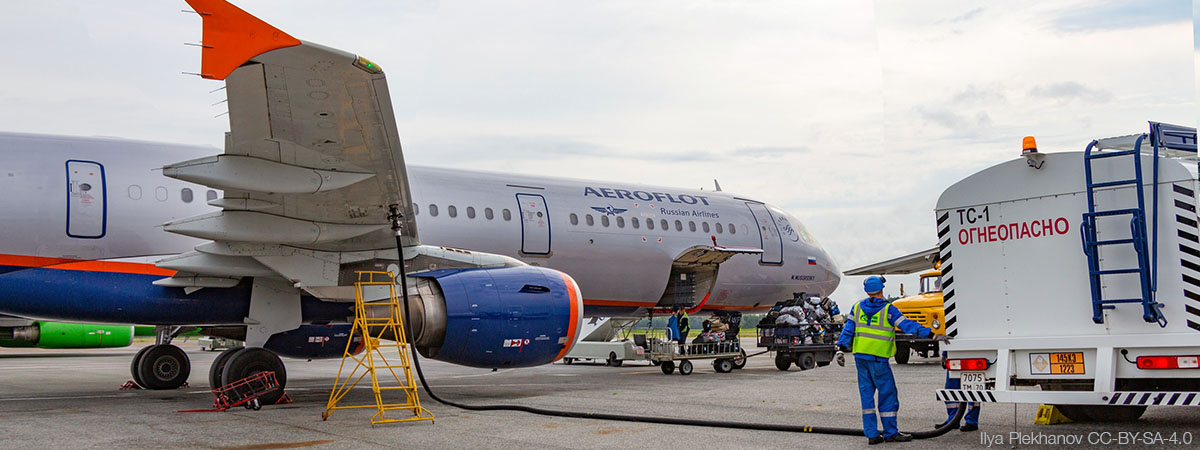When you are at an airport watching the different aircraft arriving and departing – can you pinpoint the source of energy moving them? Housed in its wings, each aircraft carries a portion of the 360 billion litres of fuel that IATA estimates were consumed in 2019 by commercial flights alone.
At the end of World War II, most aviation fuels were based on kerosene. In subsequent years, the exact specifications have been adjusted to ensure the availability of globally compatible fuels.
For some years an important effort has been made to develop renewable and viable alternatives for aviation fuel.
Kerosene, obtained from the distillation of crude petroleum, is the main component of the fuel used by commercial jet-engine aircraft, sold under the names Jet A and Jet A-1.
The former is only supplied in the United States, following the specifications of its own ASTM standard, whereas Jet A-1 is the standard fuel used throughout the world. It has a flash point above 38 °C and an autoignition temperature of 210 °C, and is therefore considered safe enough for use in large aircraft.
To further improve its characteristics, it also contains other fuel additives. These, for example, prevent aviation fuel from becoming electrically charged or from burning uncontrollably.
Other additives lower the fuel’s freezing point to -47 °C. This eliminates the risk of the fuel freezing, which is a necessary measure, as the air temperature at cruising altitude is usually below -30 °C.
Finally, it is also worth mentioning the use of additives that prevent the growth of organisms in aviation fuel or the formation of deposits in the turbine.
It is also very important that jet fuel remains free of water. In most commercial aircraft, engines are placed under the wings, and have a gravity-feed fuel system. If dissolved water precipitates and freezes due to the low temperatures outside the aircraft, it could block the fuel intake valves, as it is denser than the fuel.
In order to ensure the quality of the fuel, inspections are carried out to check that the aforementioned characteristics are met throughout the whole manufacturing, transport and storage process.
In other areas of civil aviation, instead of kerosene, they work with aviation gasoline, also known by the abbreviation avgas. Avgas is used in the piston engines that are found on sport and private aircraft. This gasoline is distinguished from that used in non-aeronautical engines by its stability, safety and high performance.
The range of options available for military fuels is much wider. Military fuels generally offer better anti-corrosion and antioxidant properties compared to fuels used in civil aviation.
A common military fuel is Jet B, which is a mixture of approximately 65% gasoline and 35% kerosene. It is intended for regions with particularly low temperatures, as it offers a freezing point that can reach -72 °C and a flash point of 20 °C, making it more flammable.
However, the engines it is used in have to be adapted to this purpose.
The use of some types of fuel can become very specific, as is the case for the fuel used in aircraft housed in aircraft carriers, where the risk of fire is particularly high. These are therefore manufactured with a higher flash point, which also makes them more expensive.
Extreme examples of this specialisation include the F-76, a naval fuel for ships operating with state-of-the-art turbines; TS-1, a Russian variant based on their own regulations, which offers better performance in cold climates; and JPTS (Jet Propellant Thermally Stable), designed for aircraft that fly at high altitudes, such as the Lockheed U-2.
However, this tendency towards the use of petroleum products is set to change in the near future.
From the point of view of resource availability, between 2003 and 2008, the price of a barrel of petroleum increased by about five times. This set a time frame within which total world oil production would be unable to meet the aeronautical industry’s demand.
Looking back, according to IATA data kerosene consumption has continued to increase by up to 30% in the last 10 years, in line with the worldwide increase in air traffic.
Although the price of a barrel of kerosene has been falling for some years, as a product obtained from fossil fuel, it will undoubtedly end up becoming more expensive in the long term. The fact that there are few alternatives to petroleum for aviation fuel increases the urgency of finding solutions.
A race has therefore been going on for some years now, searching for renewable alternatives. One of the options available is biokerosene, a term that is applied to blends in which biokerosene is the sole component as well as those in which it is blended with traditional kerosene.
The ideal raw material candidates for producing biokerosene are different species of algae; however, this possibility is still being developed. In the short term, the use of vegetable oils is being considered.
However, advances in the use of new fuels pose a problem both in terms of implementation times and in economic terms, as their introduction sometimes requires complex modifications of aircraft engines.
In terms of environmental protection, the use of substances that help in this regard, such as synthetic fuels like Synthetic Paraffinic Kerosene, has been proposed. This blend is manufactured from residues of sugar, corn, or forest harvesting. According to the FAA, it could reduce greenhouse gas emissions by up to 85%. With measures like this, air quality around airports will increase, which is of particular importance in airports located in the middle of large cities.
It is only a matter of time, decades at most, before the aviation industry undergoes these changes. The general predisposition towards change is a positive sign, as institutions, airlines, fuel producers, research centres and universities join forces to ensure that alternatives arrive in good time and as efficiently as possible.



